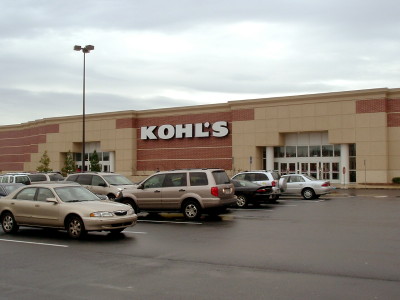
Source: Kohl's
Department stores have borne the brunt of the widening rich-poor gap. While the rich continue to patronize luxury retailers and off-price retailers gain resonance with penny-pinching consumers, department store operators have resorted to store closures and lay-offs to keep themselves alive. Is Kohl's (KSS -2.01%) any different from its peers?
It's possible to draw insights from peers like Burlington Stores (BURL -1.11%) and Kirkland's (KIRK -12.78%) to gain a better understanding of Kohl's competitive advantages.
Attractive value proposition
Consumers are always looking to get a bigger bang for their buck. In other words, they want retailers that can provide the best of both worlds in terms of low prices and differentiated products.
While Kohl's has traditionally been known as a family focused, value-oriented department store, it has sought to further cement its positioning. Kohl's has attracted and rewarded its loyal customer base with its Kohl's Cash and Kohl's Charge Savings programs in the past. Under the Kohl's Cash scheme, customers are presented with one $10 Kohl's Cash coupon for every $50 spent. On the other hand, Kohl's Charge Card customers are rewarded with monthly discounts of up to 30%.
In addition, it has further extended its loyalty program Kohl's Rewards, which was first piloted in Texas in late 2012. Kohl's Rewards guarantees members eight savings offers annually and a $5 reward for every 100 points accumulated.
Fast forward to the first quarter of 2014, and Kohl's Rewards is now available in California, Texas, and Pittsburgh, and the company plans to expand it to Milwaukee and Seattle this year. Based on its experience in Texas, stores that offer Kohl's Rewards have seen a 150-250 basis-point difference in comparable store sales growth versus other stores.
With respect to its merchandising, Kohl's prides itself on its 'Only at Kohl's' strategy, which employs a good mix of private label and exclusive brands. While Kohl's has historically delivered excellent gross margins in the mid-30s and double-digit operating margins because of its focus on higher-margin private label products, it's careful not to alienate customers who might prefer national brands.
Kohl's increased the proportion of national brands as a percentage of its total product portfolio from 44% in the second quarter of 2013 to 47% in the third quarter. Kohl's has stated that it will maintain a balance between its high-margin private label products and crowd-pulling national brands to maximize customer traffic, while keeping margins at a healthy level.
Another retailer which has gone down the dual path of product differentiation and low cost strategies is off-price retailer Burlington Stores. Similarly to its off-price peers, Burlington Stores relies on low prices to attract customers. Its 'Everyday Low Price' model offers 60%-70% discounts off of items sold at regular department stores.
When it comes to product differentiation, Burlington focuses on major, nationally recognized brands. While its off-price peers typically stock up on pack-away merchandise and pre-season cuttings, Burlington capitalizes on in-season opportunistic purchases so its assortment remains on-trend and relevant with its customers. Support for this strategy comes from its large average store size of between 50,000 and 80,000 square feet, which allows it to sell a wider range of products.

Source: Kohl's
Store differentiation
Unlike most of its retail peers which have stores located in malls, Kohl's has differentiated itself with a focus on off-mall locations. As of end-2013, Kohl's has close to 93% of its stores situated off-mall in areas such as strip centers along with free-standing locations.
Imitation is the best form of flattery. Kirkland's, a multi-channel specialty retailer of home decor and accessories, has also transitioned to an off-mall strategy. The proportion of off-mall locations among its stores has increased from approximately 50% in 2006 to about 90% now. In its most recent 2013 10-K filing, Kirkland's claimed that its off-mall stores generated higher revenue than its mall-based stores.
Off-mall locations represent a win-win situation for both consumers and retailers like Kohl's and Kirkland's. From the perspective of shoppers, malls have become too large for their own good as they have become complex mazes. As a result, malls have become increasingly difficult to navigate and have lost popularity with time-pressed consumers. In contrast, off-mall locations tend to be closer to consumers, which makes them more convenient for regular purchases.
While Kohl's doesn't disclose its sales per square foot by location type, research conducted by McGladrey in October 2013 indicated that Kohl's enjoyed a 40% premium in overall sales per square foot over a competing department store operator with a similar average store size of approximately 90,000 square feet. This validates the view that Kohl's off-mall locations are more valuable.
Viewed from the retailers' angle, off-mall locations typically offer lower rents than mall-based stores. Kohl's also has a higher chance of becoming the anchor tenant in such off-mall locations, which gives it further bargaining power in lease negotiations. Moreover, Kohl's stores are also far more visible in strip centers and freestanding locations than they would be if they were part of large regional malls.
In addition to store location, the in-store shopping experience is an equally important component of customer retention. Kohl's also has an edge here, with about half of its current stores either newly built or remodeled in the past five years. This ensures that Kohl's retains its sense of 'newness' in front of its customers.
Foolish final thoughts
In the first quarter of 2014, Kohl's reported disappointing results, with a 3% decline in comparable-sales growth and a 9% fall in diluted earnings per share. Nevertheless, Kohl's stands out among its department store peers with its value pricing, dual focus on national and private label brands, and off-mall store strategy.



